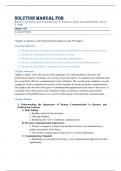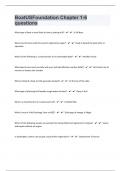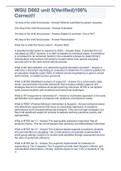Solution Manual For
Business and Professional Communication 5 th Edition by Kelly Quintanilla Miller, Shawn
T. Wahl
Chapter 1-14
Lecture Notes
Chapter 1: Business and Professional Excellence in the Workplace
Learning Objectives
1.1: Identify key areas of human communication within business and professional contexts
1.2: Explain the components of the communication model
1.3: Identify the types and causes of communication apprehension
1.4: Discuss communication and professional excellence from an ethical perspective
1.5: Identify the four KEYS to communication in the workplace
Chapter Summary
Chapter 1 begins with a discussion of the importance of communication in business and
professional contexts. It includes an overview of several aspects of communication influence that
are essential for effective communication in the workplace. The second major emphasis is on the
complexity of the communication process of the elements that make up human communication.
The chapter also describes four types of communication apprehension and some of the causes. It
concludes with a discussion of the centrality of ethics in business communication and the
importance of the KEYS process as a way for professionals to develop their communication.
Chapter Outline
I. Understanding the Importance of Human Communication in Business and
Professional Contexts
A. Role-Taking
1. Sending and receiving messages
2. Offering feedback
3. Identifying the ―role‖ of different communicators
B. Previous Communication Experiences
1. Positive or negative, it helps form the basis for how you communicate in
similar transactions in the future.
2. Your initial communication impression is of critical importance.
C. Communication Channels
1. Depending on your physical location, your communication approach can alter
significantly.
, 2. People feel comfortable taking a more aggressive or assertive tone when using
email than when engaging in face-to-face communication.
D. Cultural Influences
1. Culture is an ongoing social institution that has its own set of behavioral rules.
2. To be a competent communicator in your organization, you must be dynamic in
adhering to the rules and norms of different communication situations.
E. Communication Relationships
1. Perceived social hierarchy between communicators, whether they be strangers
or intimates, significantly influences the nature of the communication interaction.
II. Communication: A Complex Process
A. Sender and Receiver
1. Senders encode messages for receivers to decode, thereby cocreating a
meaningful message.
2. Sometimes communication does not occur in the sender and receiver format,
but rather in a more holistic manner.
B. Message and Feedback
1. Since messages have verbal and nonverbal components, some argue that you
cannot not communicate.
2. Feedback is often sent from the receiver to the sender. Feedback reminds us, as
communicators, to look for cues from the other person or persons with whom we
are communicating.
C. Channel
1. The channel is the method by which you send your message.
2. Many different channels to send messages are available.
3. Each channel has strengths and weaknesses.
D. Context
1. Context refers to the location, time, and occasion where communication occurs.
2. It is helpful to assess your communication context and use that information
when developing your message.
E. Noise
1. External noise refers to audible sounds that distract from proper
communication.
2. Internal noise refers to any internal condition or state that interferes with the
communicator’s ability to focus on the message.
III. Communication Apprehension
A. Types of Communication Apprehension
1. McCroskey (1982) defines communication apprehension as ―an individual’s
level of fear or anxiety associated with either real or anticipated communication
with another person or persons‖ (p. 137).
, 2. The four types of communication apprehension are as follows.
a. Trait apprehension refers to the tendency for shy people to feel anxious when in
communicative contexts.
b. Context-based apprehension describes the fear of communication in certain
contexts, such as public speaking.
c. Audience-based apprehension describes the fear of communication with certain
people or groups of people.
d. Situational apprehension refers to the fear of communication in specific
circumstances, such as job interviews.
B. Causes of Communication Apprehension
1. Communication scholar Michael Beatty lists eight causes for communication
apprehension: novelty, formality, subordinate status, peer evaluation,
dissimilarity, conspicuousness, lack of attention, and prior history.
2. Identifying causes of apprehension is important to help learn the skills that
reduce those fears.
IV. Communication Ethics
A. Ethics
1. General term for the discussion, determination, and deliberation processes that
attempt to decide right or wrong, what you should or should not do, and what is
considered appropriate
B. Ethical Considerations
1. Include lying, keeping and/or telling secrets, maintaining integrity, engaging in
aggressive communication, and cheating
C. Ethical Dilemmas
1. Situations that do not seem to present clear choices between right and wrong or
good and evil
D. Values
1. Moral principles or rules that determine ethical behavior
E. Organizational Values
1. Specific principles or guidelines such as safety, teamwork, integrity, or
ownership that are typically outlined in support of any given organizational
mission or goal
V. KEYS for Excellence in the Workplace
A. Know Yourself
1. Actively assess your skills as a communicator and then develop strategies to
utilize your strengths and weaknesses
B. Evaluate the Professional Context
1. Proactively address the needs of your audience and understand the constraints
of the communication situation
, C. Your Communication Interaction
1. Requires you to monitor your verbal and nonverbal cues in addition to the cues
from the audience
D. Step Back and Reflect
1. Examine the effectiveness of verbal and nonverbal messages you convey to
others and the success of the interactions
Lecture Notes
Chapter 2: Verbal and Nonverbal Communication
Learning Objectives
2.1: Define verbal communication
2.2: Define nonverbal communication
2.3 Identify and define the codes of nonverbal communication
2.4. Discuss examples of how verbal and nonverbal communication are related
2.5. Apply the KEYS approach to conduct yourself with professional excellence through
verbal and nonverbal communication in the workplace
Chapter Summary
Chapter 2 defines verbal and nonverbal communication. It also covers how to appraise your
verbal and nonverbal communication skills. In addition, this chapter discusses how verbal and
nonverbal communication are related. Finally, it applies the KEYS approach to professional
excellence outlining how to improve verbal and nonverbal communication in the workplace.
Chapter Outline
I. Verbal Communication
A. What Is Verbal Communication?
1. Verbal communication is created through language, encompassing both our
words and verbal fillers.
2. The symbols communicators use are abstract, vague, and sometimes arbitrary.
3. Verbal communication uses communication rules, or the shared understanding
of what communication means and what constitutes communication in given
contexts.






